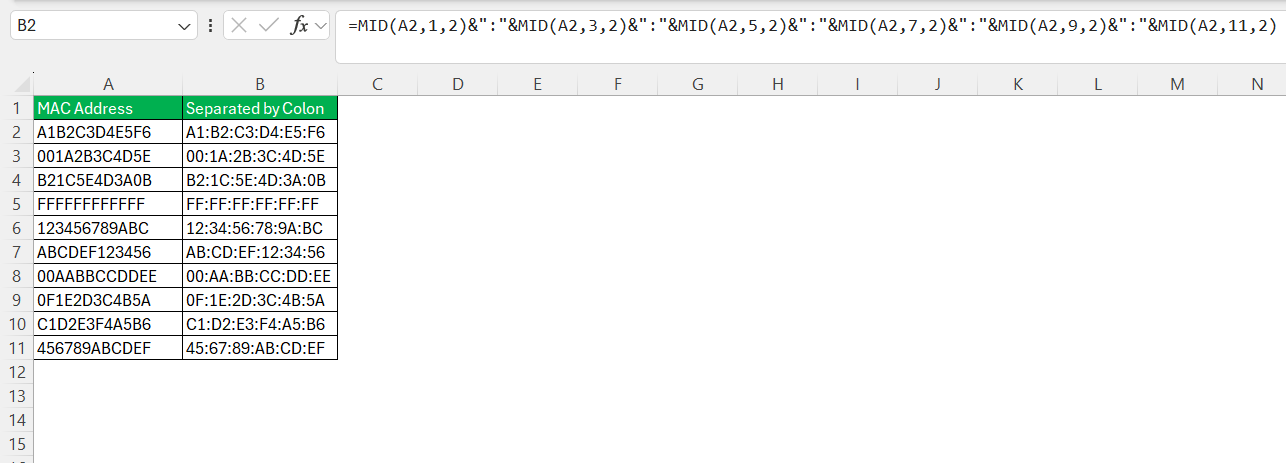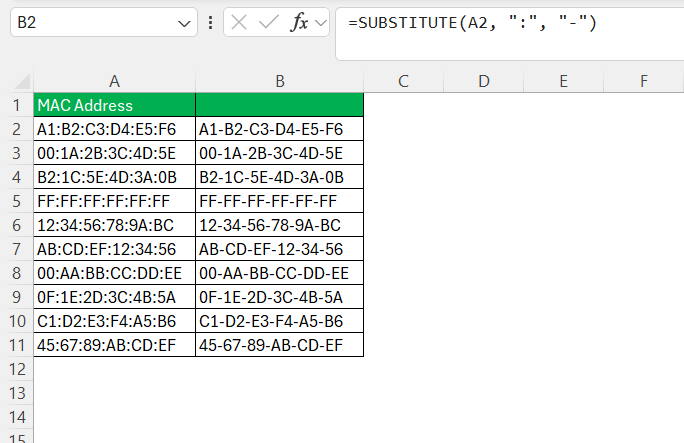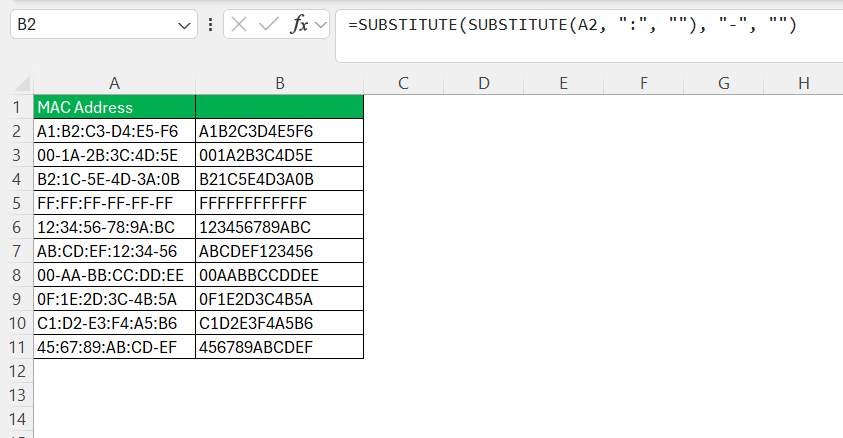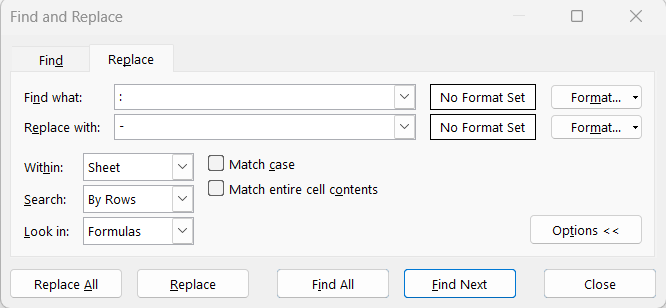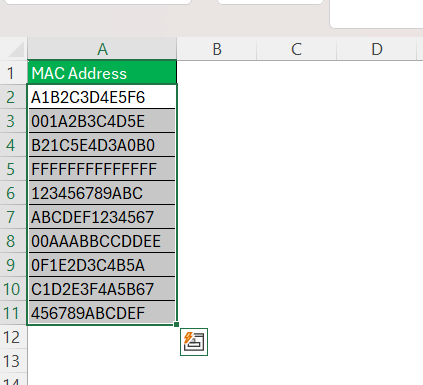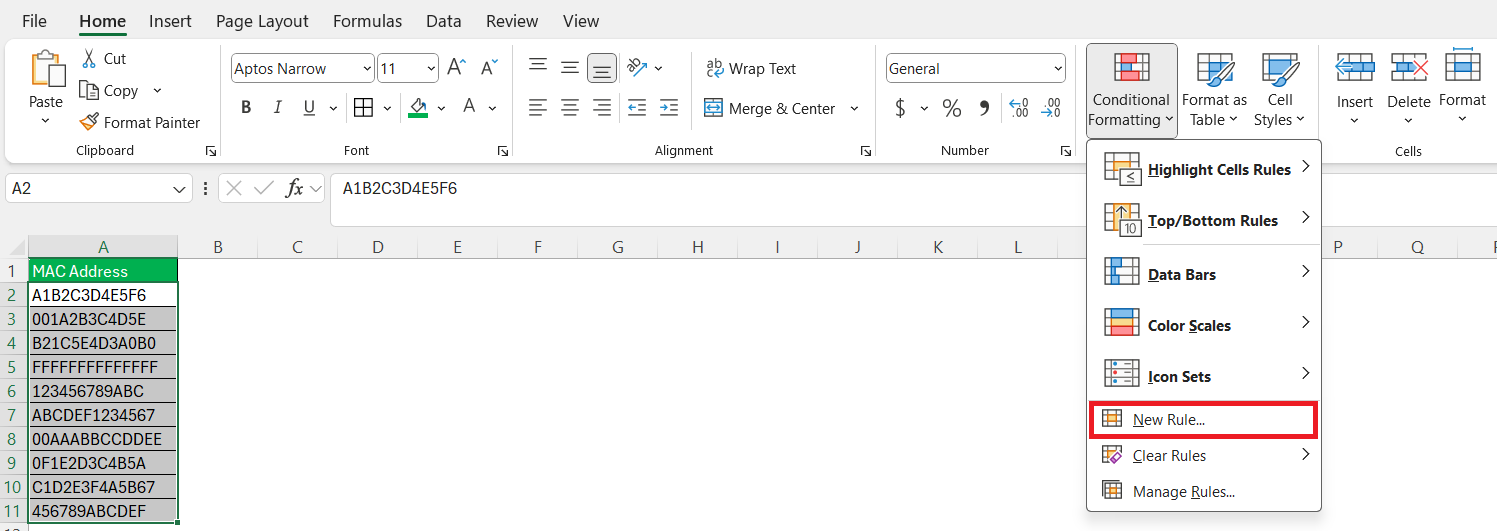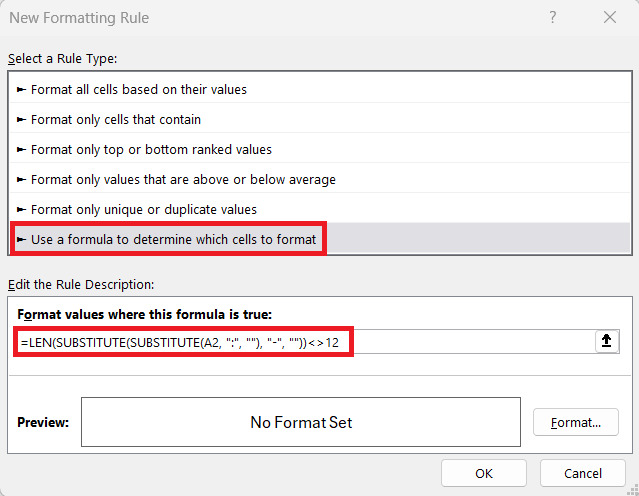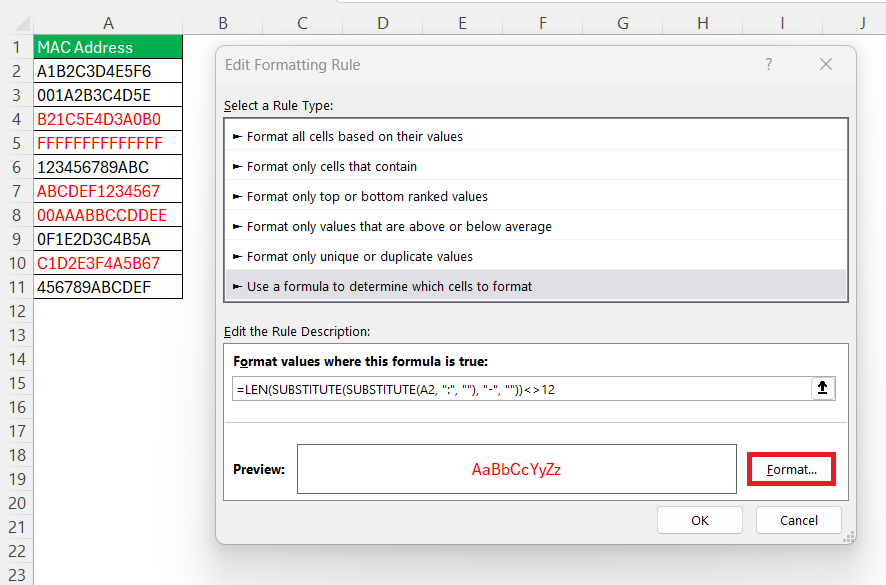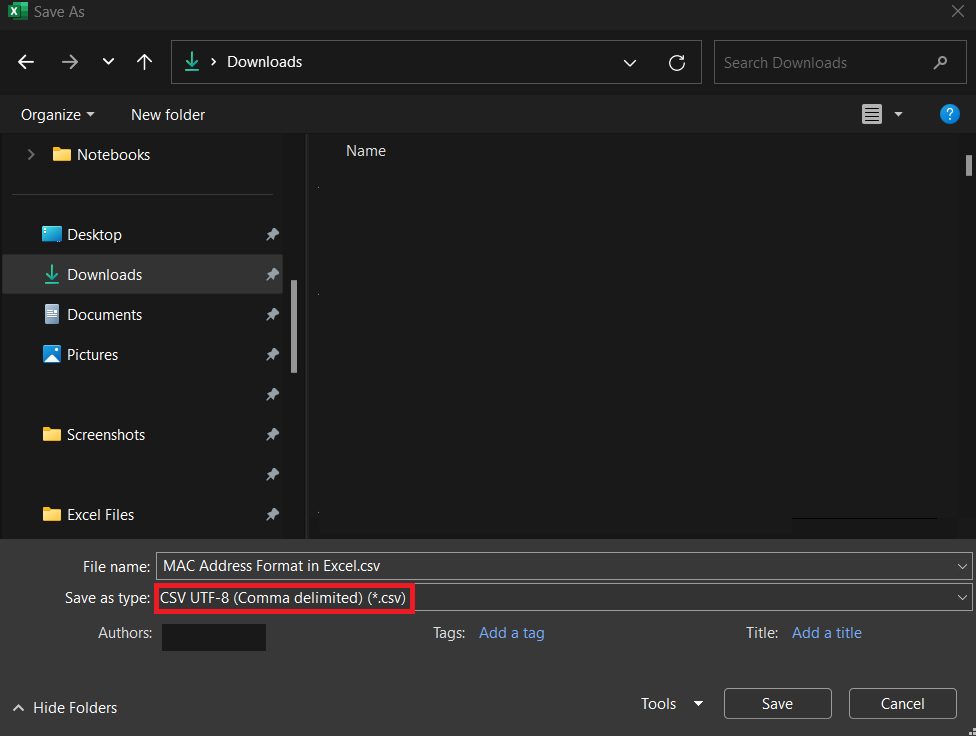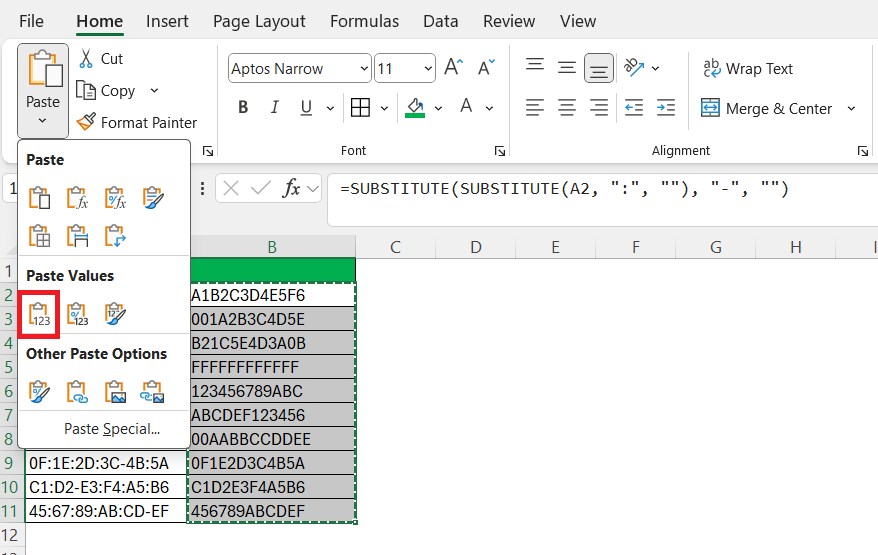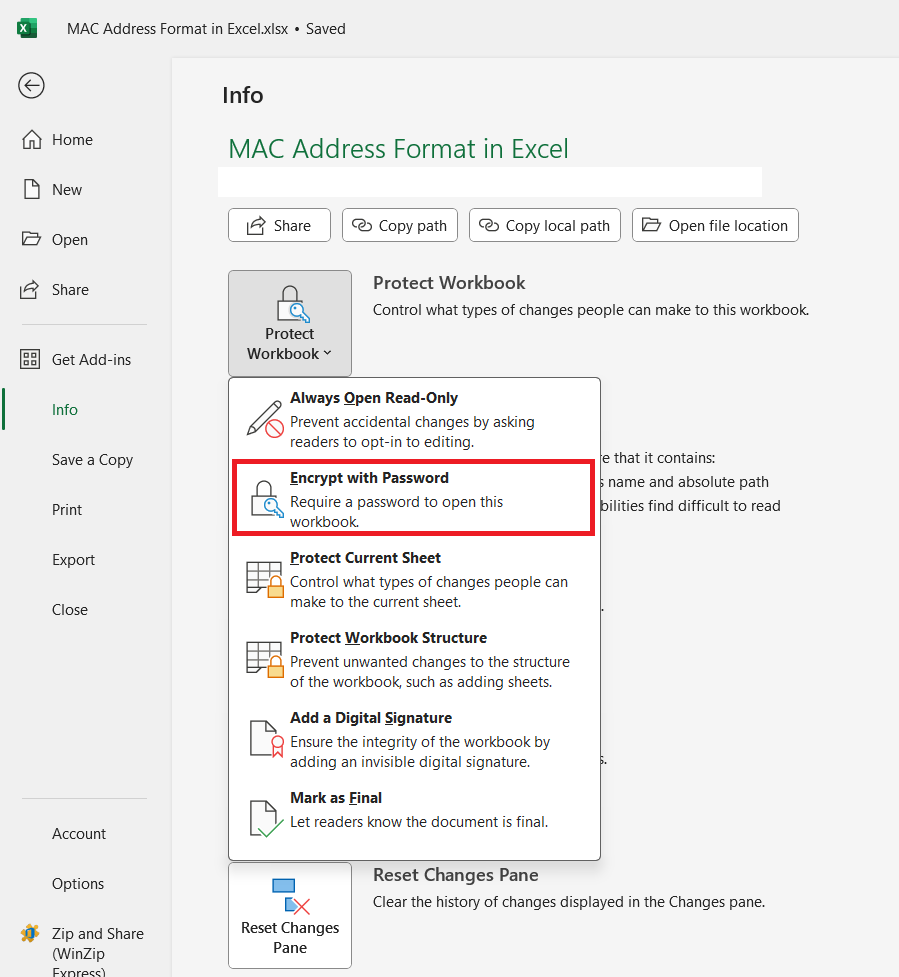When working with network-related data in Excel, you may encounter MAC addresses that need to be recorded, analyzed, or standardized. As unique identifiers assigned to network interfaces, MAC addresses have a specific format, which is essential to recognize when managing networked devices. In this guide, I’ll take you through what MAC addresses are, their structure, and the various ways you can MAC address format in Excel.
Key Takeaways:
- MAC addresses are unique identifiers for network devices and are essential for network management.
- Standard MAC address formats include colon-separated, hyphen-separated, and unformatted styles, each useful in different scenarios.
- Excel functions like
MID,LEFT,RIGHT, andSUBSTITUTEcan help MAC addresses format. - Conditional formatting can be used in Excel to validate MAC address formats, highlighting any errors in structure.
- For secure sharing, encrypting and backing up your Excel file ensures safe data handling, especially when sharing sensitive network data.
Table of Contents
Introduction to MAC Address
What is a MAC Address?
A MAC address, or Media Access Control address, is a unique identifier for network interfaces used in communications within a network segment. This hardware identifier helps in the management of data transmission at the data link layer of the OSI model. MAC addresses are distinct and generally pre-assigned to network cards or adapters by the manufacturer—kind of like a serial number.
Structure of a MAC Address
A MAC address typically has a format like XX:XX:XX:YY:YY:YY, where each X or Y is a hexadecimal digit (0–9, A–F). The format is consistent, with 12 hexadecimal characters in total, structured as six pairs. Here’s a quick breakdown:
- First Six Characters (
XX:XX:XX) – Identify the device manufacturer. - Last Six Characters (
YY:YY:YY) – Unique device identifier assigned by the manufacturer.
Let’s look at some standard formats:
- Hyphen-separated:
A1-B2-C3-D4-E5-F6 - Colon-separated:
A1:B2:C3:D4:E5:F6 - No separator:
A1B2C3D4E5F6
Each format can be beneficial in different scenarios, so it’s handy to know how to convert between them in Excel.
Step-by-Step Guide to MAC Addresses Format
Using Excel Functions for Formatting
To format MAC addresses in Excel using functions, let’s start by examining a common approach with the ‘MID’, ‘LEFT’, and ‘RIGHT’ functions. Here’s the basic principle: A MAC address that looks like ‘aabbccddeeff’ can be formatted to ‘aa:bb:cc:dd:ee:ff’ by inserting colons at the appropriate intervals.
STEP 1: First, ensure your raw MAC address is in a cell (let’s say in column A).
STEP 2: In the adjacent cell, you could use a formula such as: =MID(A1,1,2)&":"&MID(A1,3,2)&":"&MID(A1,5,2)&":"&MID(A1,7,2)&":"&MID(A1,9,2)&":"&MID(A1,11,2). This breaks down the address in pairs of two and inserts colons using concatenation (&).
Press ‘Enter’, and you’ll see your formatted MAC address.
The ‘MID’ function extracts characters from the middle of the text based on a starting position and length that you specify. ‘LEFT’ and ‘RIGHT’ functions can be used similarly to extract characters from the beginning or end of a text string, respectively.
By using these functions in combination, you can quickly format rows of raw MAC addresses, maintaining a clean and usable dataset.
Tips & Tricks while formatting MAC address
Solving Inconsistent Delimiter Challenges
Inconsistent delimiters within MAC addresses in Excel can lead to confusion and data processing errors. For example, if some addresses use colons (aa:bb:cc:dd:ee:ff) while others use hyphens (aa-bb-cc-dd-ee-ff) or no delimiter at all (aabbccddeeff), it can cause issues with sorting, searching, and network tools.
To solve this challenge, we may employ the ‘SUBSTITUTE’ function, which replaces existing delimiters with a consistent one, or removes them entirely:
- To replace colons with hyphens:
=SUBSTITUTE(A1, ":", "-")
- To remove all delimiters:
=SUBSTITUTE(SUBSTITUTE(A1, ":", ""), "-", "")
When adapting to local settings, such as using semicolons (;) instead of commas (,) as delimiters in formulas, understanding and adjusting to the correct list separator for the Excel version being used is essential. This helps avoid errors and ensures that the function arguments are correctly recognized by Excel.
After standardizing the delimiters, using features like ‘Find and Select’ can help check for inconsistencies across the dataset, ensuring all addresses follow the desired format.
Ensuring uniformity in the dataset’s MAC addresses not only makes them easier to read but also supports consistent reporting, data import/export, and integration with other systems.
Conditional Formatting for MAC Address Validation
Ensuring that every cell has a valid MAC address format can prevent errors in your data. Using Excel’s Conditional Formatting feature, we can highlight cells that don’t match the expected format.
STEP 1: Select the cells you want to validate (e.g., A2:A11).
STEP 2: Go to Home > Conditional Formatting > New Rule.
STEP 3: Select Use a formula to determine which cells to format. Enter the following formula:
=LEN(SUBSTITUTE(SUBSTITUTE(A2, “:”, “”), “-“, “”))<>12
STEP 4: Set the format to highlight cells in red if they don’t contain 12 characters, helping you easily spot any issues.
Saving and Sharing Your Formatted Data
Exporting Formatted MAC Addresses from Excel
When it’s time to export formatted MAC addresses from Excel, it’s important to ensure that the data retains its formatting. The go-to method is to save the Excel file as a CSV (Comma Separated Values) file if I need to import it into another system.
This can be done by going to ‘File’ > ‘Save As’ and choosing ‘CSV’ from the drop-down menu.
Before exporting, double-check that the MAC addresses are displayed correctly in Excel, as this is how they will appear in the CSV file.
For scenarios where the formatted MAC addresses need to be copied into another application, using ‘Copy’ and ‘Paste Special’ as ‘Values’ can ensure that only the data—free from formulas and cell references—is transferred.
Depending on the recipient’s needs or the compatibility requirements of the destination system, I might also consider other formats such as Excel’s native .xlsx for maintaining rich formatting or .txt for plain text.
Whatever method I choose, by keeping a backup of the original Excel file with the data and formulas, it provides a safeguard against data loss that may occur during the export process.
Best Practices for Sharing MAC Address Data Securely
Sharing MAC address data securely is vital to prevent unauthorized access to network information. To do so, I would first encrypt the Excel file with a strong password before sharing. This can be done via ‘File’ > ‘Info’ > ‘Protect Workbook’ and selecting ‘Encrypt with Password’.
I would ensure that the password is complex enough to deter brute force attacks and only share the password through secure channels.
When transmitting the encrypted file, using secure file transfer methods such as SSL/TLS encryption, SFTP, or secure sharing services with two-factor authentication is a best practice. I must also be mindful of data protection regulations and compliance standards such as GDPR or HIPAA when sharing sensitive information.
It is also wise to maintain strict access control lists (ACLs) and to regularly audit which personnel have access to the MAC address data. Keeping detailed logs of who accessed the data and when will aid in monitoring and quickly identifying any unauthorized access.
Lastly, de-identifying any additional sensitive information that’s not necessary for the recipient’s purpose helps minimize risk. If the MAC addresses must be shared externally, consider whether full addresses are needed or if anonymized versions can be used, especially in the case of sharing for analysis or reporting purposes.
By adhering to these security best practices, I ensure that the MAC address data remains confidential and accessible only to authorized users.
FAQ: Mastering MAC Address Formats
How to format a MAC address?
To format a MAC address in Excel, you can use formulas to add delimiters like colons or hyphens between every two characters. For example, to format aabbccddeeff as aa:bb:cc:dd:ee:ff, use the formula =MID(A1,1,2)&":"&MID(A1,3,2)&":"&MID(A1,5,2)&":"&MID(A1,7,2)&":"&MID(A1,9,2)&":"&MID(A1,11,2) if the address is in cell A1.
How do I format different styles of MAC addresses?
Different styles of MAC addresses may require different formatting approaches. For instance, MAC addresses can be displayed with colons, hyphens, or dots as separators, and even without any separator. You would adjust your Excel formulas accordingly. For example, if you need to format a MAC address with hyphens instead of colons, replace the colon in the concatenation formula with a hyphen. Utilize the ‘SUBSTITUTE’ function to swap out delimiters if working with already semi-formatted data.
Can Excel auto-format MAC addresses as I type?
Excel can’t auto-format MAC addresses as you type by default, but you can set up a VBA (Visual Basic for Applications) macro to do so. By writing a small piece of code in the Excel VBA editor, you can trigger a formatting function whenever a cell value is changed, which would auto-format the MAC address. Remember to enable macros for this to work.
How do I format numbers in Excel for MAC?
To format numbers in Excel for Mac, you select the cells containing the numbers and then go to the ‘Format’ menu. Choose ‘Cells’, and in the dialog box, pick the ‘Number’ tab. Here, you have a variety of number formats to choose from, including ‘Number’, ‘Currency’, ‘Accounting’, ‘Date’, ‘Time’, ‘Percentage’, and ‘Custom’. For custom formats, such as a MAC address, you would use the ‘Custom’ option and define the format you need.
Is there a way to format addresses in Excel?
Yes, you can format physical addresses in Excel to ensure they are consistent and readable. It’s best to use separate columns for each part of the address—street, city, state, ZIP code, country—to facilitate sorting and searching. To combine these into one formatted address in another cell, use the CONCATENATE function or the ampersand (&) to join the different parts with commas and spaces as appropriate. For example, =A2 & ", " & B2 & ", " & C2 & " " & D2 & ", " & E2 would create a full address from individual columns.
John Michaloudis is a former accountant and finance analyst at General Electric, a Microsoft MVP since 2020, an Amazon #1 bestselling author of 4 Microsoft Excel books and teacher of Microsoft Excel & Office over at his flagship MyExcelOnline Academy Online Course.

